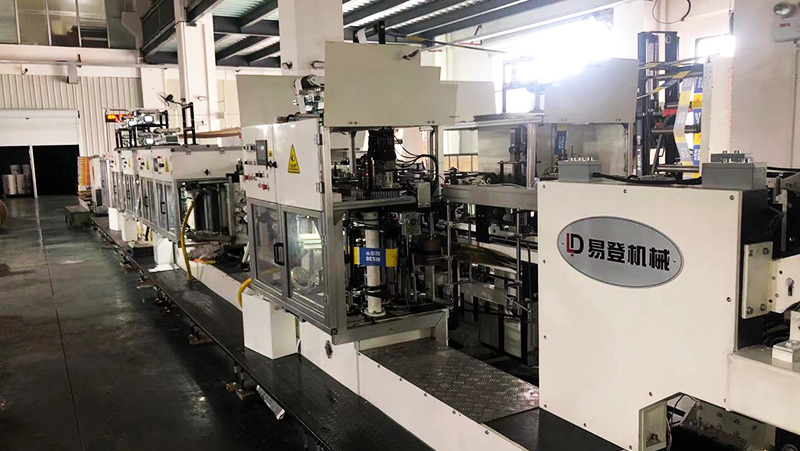Innovations in Paper Bag Sealing Systems: Enhancing Efficiency and Sustainability
Release time:2025-05-27 Classification:Knowledge
The paper bag sealing system has emerged as a cornerstone technology in modern packaging operations, addressing the growing demand for secure, eco-friendly, and cost-effective solutions across industries. As businesses prioritize sustainability and operational efficiency, advancements in sealing mechanisms have transformed how paper-based packaging is processed, stored, and delivered. This article explores the technical principles, applications, and benefits of contemporary paper bag sealing systems while highlighting their role in supporting environmentally conscious practices.

Technical Foundations of Paper Bag Sealing Systems
At its core, a paper bag sealing system employs precision engineering to create airtight, tamper-resistant closures for paper packaging. Modern systems utilize a combination of thermal, adhesive, or mechanical methods to ensure consistent seal integrity. Heat-sealing technology, for instance, applies controlled temperature and pressure to activate thermoplastic coatings on paper surfaces, bonding layers without compromising material strength. Alternatively, adhesive-based systems deploy food-grade glues or water-activated tapes for applications requiring resealable or biodegradable properties.
Advanced sensors and programmable logic controllers (PLCs) enable real-time adjustments to parameters such as temperature, pressure, and dwell time, ensuring adaptability to diverse paper grades and bag dimensions. These systems often integrate with automated production lines, synchronizing sealing with filling, labeling, and quality inspection processes to minimize downtime.
Sustainability Advantages
Paper bag sealing systems align with global sustainability initiatives by reducing reliance on plastic-based packaging. Unlike traditional plastic seals, paper-compatible adhesives and heat-sealable coatings are designed for recyclability and compostability. For instance, starch-based adhesives and plant-derived coatings decompose naturally, mitigating environmental impact. Additionally, precise sealing minimizes material waste by eliminating overuse of adhesives or energy-intensive processes.
Many systems also support the use of recycled paper substrates, further lowering carbon footprints. By ensuring leak-proof seals without laminating plastic films, these technologies enable brands to meet stringent regulatory standards for eco-labeling while appealing to environmentally conscious consumers.
Applications Across Industries
The versatility of paper bag sealing systems makes them indispensable in sectors ranging from food and agriculture to pharmaceuticals and retail:
- Food Packaging: Ensures freshness and compliance with hygiene standards for dry goods, grains, and baked products.
- Industrial Materials: Secures heavy-duty paper bags used for cement, chemicals, or construction materials.
- E-Commerce: Provides durable seals for lightweight shipping bags, reducing damage during transit.
- Consumer Goods: Facilitates aesthetically clean seals for premium retail packaging.
Operational Benefits
- Enhanced Productivity: Automated sealing systems process hundreds of bags per hour with minimal human intervention, ideal for high-volume operations.
- Cost Savings: Reduced material waste and energy consumption lower operational expenses over time.
- Quality Assurance: Consistent seal strength prevents product spoilage and reduces return rates due to damaged packaging.
- Flexibility: Modular designs accommodate custom bag sizes, shapes, and closure types (e.g., pinch-bottom, gusseted, or flat seals).
Maintenance and Longevity
To maximize the lifespan of a paper bag sealing system, routine maintenance is critical. Components such as heating elements, adhesive nozzles, and conveyor belts require periodic cleaning and calibration. Many modern systems feature self-diagnostic tools that alert operators to wear-and-tear issues, enabling proactive repairs. Additionally, manufacturers increasingly design systems with replaceable modular parts to simplify upgrades and reduce lifecycle costs.
Future Trends and Developments
The evolution of paper bag sealing systems continues to accelerate, driven by innovations in smart manufacturing and material science. Emerging trends include:
- AI-Driven Optimization: Machine learning algorithms that predict and adjust sealing parameters based on real-time data.
- Energy-Efficient Designs: Low-power heating elements and renewable energy integration.
- Biodegradable Smart Coatings: Functional coatings that enhance barrier properties while remaining compostable.
As industries pivot toward sustainable packaging solutions, the paper bag sealing system stands out as a vital enabler of both ecological responsibility and operational excellence. By combining precision engineering with environmentally friendly materials, these systems not only meet current market demands but also pave the way for a future where efficiency and sustainability coexist seamlessly. For businesses seeking to optimize their packaging workflows, investing in advanced sealing technologies is no longer optional—it’s a strategic imperative.






